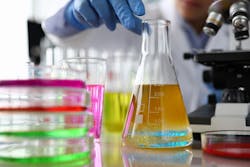Sustainability Emerging as Key Trend for Tribology Industry
As sustainability becomes a larger focus around the world, several industries are seeing the impacts including the tribology industry – a field which studies friction, wear, and lubrication by looking at how interacting surfaces behave in relative motion.
The Society of Tribologists and Lubrication Engineers (STLE) has released its 2023 Report on Emerging Issues and Trends in Tribology and Lubrication Engineering which outlines the top trends and issues facing the industry. While supply chain challenges remain at the top of the list, sustainability is emerging as a key trend affecting everyone in the tribology and lubrication fields said Dr. Neil Canter, FSTLE, CMFS Chemical Solutions, during STLE's webinar outlining highlights of the 2023 report.
Canter and STLE's Advance Innovation Team prepared the report which is updated once every 3 years with input from industry experts to get their perspective on the key factors impacting development efforts. The 2023 report outlines the six trends currently top of mind for those working in the field of tribology.
"The findings from this report indicate that individuals who are tribologists or are considering a career in tribology will have major opportunities to use their skills to make a difference in meeting challenges that will promote the growth of sustainable practices," said Canter.
1. Supply Chains
Like many industries, tribology has been impacted by the supply chain issues which began during the COVID-19 pandemic. The availability of the raw materials necessary to create lubricants and other fluids remains a challenge, making it difficult for manufacturers to produce and supply product to customers.
In some applications, there are several components which go into the fluid formulation and if even one of them is hard to get it can cause major issues for manufacturers.
Canter said there has been some alleviation in this area, but other factors such as weather events are creating issues. These are hindering logistics, and thus deliveries, and in some cases even shutting down production of oil refineries or other businesses which feed into the supply chain.
He said the availability of raw materials, weather and other factors will likely continue to plague the supply chain in the future.
Though sustainability is a trend of note on its own, it will play a part in supply chains and the other trends impacting tribology as well. Most notably for supply chains are the efforts being made to create lubricants from more sustainable sources and extending the lifespan of materials. Instead of just disposing of a fluid once it is past its useful life, some in the field are looking at how raw materials and finished products could be reused over and over again.
This circular economy reduces the amount of raw materials necessary to produce lubricants and keeps them out of landfills, all of which benefit the environment and sustainability initiatives. And it can help supply chains by creating a means of more easily producing and delivering products.
2. Sustainability
Sustainability has become increasingly important in recent years due to the global population's growing concern about the environment. Although a succinct definition of what sustainability entails is difficult, currently it is mostly concerned around the need to minimize rising global temperatures.
Studies have shown the important role tribology can play in reducing emissions, an important part of the sustainability equation. Canter pointed to one of the initial reports noting this fact, "Tribology Opportunities for Enhancing America's Energy Efficiency" from the U.S. Dept. of Energy (DOE), which was prepared by tribology researchers. The report noted the considerable energy savings which could be achieved using existing and new tribology approaches, leading to emissions reductions.
Per the DOE report, more than 22 quads of energy (1 quad = 1 x 1015 BTU = 1.055 x 1018 Joules) could be saved each year in the U.S. through tribology developments. If even a fraction of this were to be achieved, it would go a long way toward helping reduce the amount of carbon dioxide (CO2) produced each year in the U.S. as well as global efforts to prevent the earth from warming to 1.5 C by 2030 — the point at which the majority of the scientific community has agreed will be catastrophic for the earth and its inhabitants.
The creation of a circular economy for the production of lubrication noted above is just one of the ways in which the industry can do its part to help with emissions reduction efforts. By reusing products, or producing them from different types of materials such as recycled plastic, there is also the potential to reduce emissions typically created during the manufacturing process as well as material sourcing.
To be more sustainable, many companies and other industry entities are looking at different scope values to better understand the total carbon footprint associated with sourcing, manufacturing and delivering their products. As outlined by Canter during the webinar:
- Scope 1– direct emissions such as those generated at a manufacturing plant.
- Scope 2 – indirect emissions often associated with an operation's power source, such as electricity and how that is generated by the local utility (coal, wind or other).
- Scope 3 — indirect emissions produced by upstream and downstream business partners such as the suppliers of the raw materials for lubricant production.
In general, it is viewed that moving toward increased use of renewable energy/sources for fuel, electricity, raw materials and more will benefit global emissions reduction goals.
3. Electrification
Canter said the electrification trend involves more than just the transition to battery-electric vehicles. While a part of the equation, it really has to do with using alternative power sources — including fuel cells, solar and wind — to generate energy.
Development and market availability of battery-electric vehicles has of course grown in recent years due to technology advancements and a greater desire for such vehicles. Almost every transport industry, from passenger cars to trucks and buses to construction equipment, is going electric, bringing with it new considerations for design teams including those on the tribological side of things.
READ MORE: Construction Equipment Digs Deeper into Electrification
A whole new approach to lubricants will likely be needed for electric vehicles said Canter for both thermal management and lubrication. Lower viscosity fluids for heat transfer will be required, but it will also be necessary to keep electrical properties in mind because the fluid cannot be too insulating or too conductive otherwise performance issues could occur. Other factors he said will be important to consider include:
- extreme pressure protection,
- oxidation and sludge control,
- compatibility of additives due to high amounts of copper in electric vehicles, and
- balancing of additives for efficiency, durability, noise, vibration and harshness.
Because of these aspects, new technologies and formulas may be required. In addition, Canter noted new materials for seals, resins, coatings and plastics are being utilized which create further factors to be taken into consideration when developing lubricants for electric vehicles.
With the electrification trend will come greater demand for electricity. This is not only due to the need to charge electric vehicles but also the greater implementation of digitalization in various fields such as manufacturing and even in tribology. Increased use of the internet, data transmission centers and more is leading to further growth in electricity consumption.
From a tribology standpoint, Canter said this brings a greater need for heat transfer fluids. He explained that many data centers, for example, use tremendous amounts of electricity which generate large amounts of heat. Development of heat transfer fluids for these applications, as well as electric vehicles, will help to prevent heat buildup which could cause performance issues.
4. Manufacturing
Automation and the implementation of Industry 4.0 technologies — as well as the start of Industry 5.0 — are key drivers in the manufacturing sector which could have implications on the tribology industry. Related to these are the concepts of machine learning (ML) and artificial intelligence (AI) which can be applied to tribology and thus are reviewed in the STLE report said Canter.
READ MORE: How Machine Learning Could Aid the Design Process
He noted the report also looks at additive manufacturing (AM), also referred to as 3D printing, which is also growing in use in the manufacturing sector for production of prototypes, spare parts and more. Canter said there are still a lot of aspects that need to be worked out regarding the use of AM, but there are also many benefits the manufacturing industry sees to its use once many of the hurdles are overcome, including the fact it is considered to be more sustainable as there is less material used and often less machining required.
Also important to tribologists are the changes in bearing designs that are likely to occur for the manufacturing sector. Canter said bearings are going to need to become smaller and more efficient to help improve the performance and energy use of the machines into which they are integrated.
According to Canter, one of the key aspects for this sector going forward will be determining how to integrate tribology and sustainability into manufacturing. He said bringing them together as part of a plant reliability program can help to improve the productivity and safety of a manufacturing operation.
Sustainability will become a more active part of manufacturing through improvements in production efficiency, energy savings and reduced emissions. This will also be seen through increased use of synthetic lubricants which are proving to provide better performance and longer run times in addition to environmental benefits. Water-based lubricants could be an option in the future as well but are not yet available.
5. Medical/Health
Tribology is becoming particularly beneficial in the health and medical fields said Canter. It can come into play with contact lenses, orthopedics, implants and various other applications in this field.
By better understanding how implants interact with adjacent body parts or natural tissues within the body work with one another, there can be greater efforts made to improve lubrication to reduce friction, as an example, and thus improve comfort for patients.
Canter noted that getting down to the cell level and understanding how body cells deal with friction could lead to the development of synthetic, water-based lubricants for use in the body to help alleviate friction issues which can occur with implants.
6. Government Regulations
The STLE report reviews both global and regional government regulations impacting tribology, many of which are related to emissions reduction and other sustainability efforts – further demonstrating how impactful a trend sustainability has become. Several regulations noted aim to increase use of diesel alternatives and push various industries toward zero emissions in an effort to reduce the warming of the planet.
Regulations highlighted in the report include MARPOL which aims to reduce emissions from the marine sector and on-road vehicle regulations such as Euro 7, China 6b and Phase 3 GHG regulation in the U.S. Each of these are designed to reduce the amount of emissions produced by newly built cars, trucks and buses with eventual goals of completely eliminating emissions in future regulations.
Also covered are those regulations addressing use of raw materials, including some which are used for greases and other fluids. Lithium salt, for instance, is currently under scrutiny by the European authorities as a potential toxic substance for the environment. This material is an important element of lithium-ion batteries as well as greases; a regulation mitigating its use could pose challenging to manufacturers.
Canter said the grease industry has already begun looking at how to shift away from use of this material due in part to the battery industry's demand for it which has constricted supply availability.
Biocides, chlorinated paraffin and per- and polyfluoroalkyl compounds (PFAS) are other materials used in the lubrication industry which are being regulated as well, or could be in the near future.
So how will the findings of the STLE report truly impact those in the field of tribology? Canter concluded the webinar by saying the industry should look at where the lubricant end users are as sustainability is emerging as a key driver for them to improve productivity, reduce emissions, and reduce waste. Lubricants can help with these efforts; there are many technologies that will need to be replaced in the coming years to achieve various customer and sustainability goals.
The full STLE 2023 Report on Emerging Issues and Trends in Tribology and Lubrication Engineering can be downloaded from the society's website.





